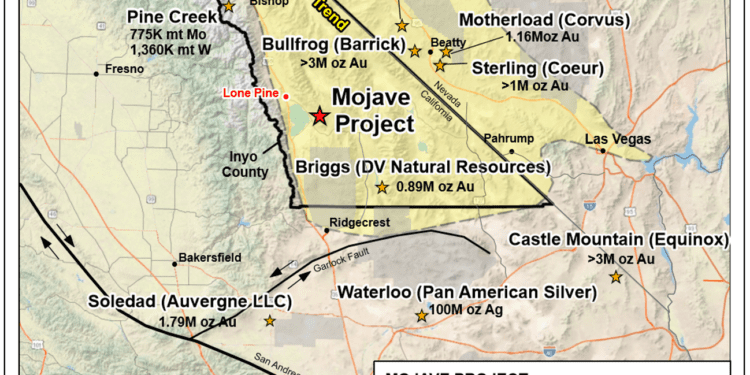Samples New Large Regional Gold Target
K2 Gold Corporation (TSX-V: KTO) has completed its maiden Phase 1 drilling programme of 17 RC drill holes for a total of 2,540m at its Mojave project located in Inyo County, Southern California.
“We are pleased to have completed this initial drilling programme at Mojave, the first such programme since the project was successfully drilled by BHP in 1997. Initial assay results are expected within the next month,” said Stephen Swatton, President and CEO of K2.
“The results from the first phase of drilling will lay the groundwork for a larger exploration program. An application for a modified Plan of Operations utilising an existing reclaimed exploration road for the second phase of drilling is expected to be submitted to the Bureau of Land Management by December.”
The Phase 1 drilling campaign has been completed on the Eastern side of the 5,830 ha (14,406 acre) Mojave property. The drilling programme focused on the Dragonfly and Newmont target areas; two gold rich zones within a 4.5km strike length of known mineralisation.
The deepest hole was drilled to a vertical depth of 201.2m. All historic holes drilled by Newmont and BHP within the Newmont and Dragonfly targets intersected alteration and anomalous gold mineralisation.
The drilling was conducted from four sites: two on Dragonfly (DF-1” and “DF-2) and two on Newmont (NM-1 and NM-2), with multiple holes drilled from each site. A total of eight holes were completed on the Dragonfly and nine holes completed on the Newmont with the drilling designed to evaluate the extent of mineralisation intercepted in the historic Newmont and BHP drill programmes.
All samples from the programme have been shipped to MSALABS in Langley, BC and initial results for the program are anticipated within four weeks.
Mr Swatton said positive results from the first phase of drilling will provide support for an expanded second phase of drilling. The permitting document for the larger programme is well advanced and will be submitted to the Bureau of Land Management by December.
A systematic rock chip sampling program was also conducted across the Upland Valley area, located in the centre of the Mojave property, 1.7km west of the Newmont target and adjacent to the Stega target on the western margin of the property. The sampling was conducted to follow up on previously identified alteration and iron-oxide anomalies which were recognised from recently acquired World View-3 remote sensing imagery.
A total of 422 rock chip and grab samples were collected on the target covering an approximate 2.6km x 1km area.
Mr Swatton said there is evidence of numerous workings from early exploration work, probably from the early 1900’s, but this target has not been followed up by more recent operators.
The area is characterised by large zones of quartz-carbonate (+/-barite) veining, argillic to quartz-sericite alteration and strong iron-oxide development. Alteration occurs within a package of strongly deformed Permian-Triassic calcareous sediments and porphyritic intrusive dikes and sills cut by a series of NNW trending high angle faults that are associated with the strongest zones of alteration.
In addition to Upland, additional prospecting samples and geologic mapping was conducted on the Gold Valley, Dragonfly, Newmont, and Broken Hill target areas.












